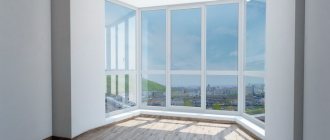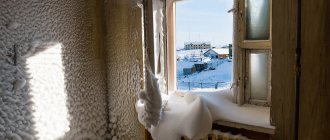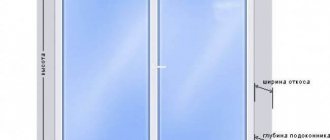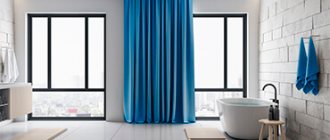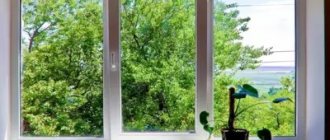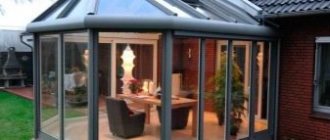Such window systems have more advantages than disadvantages, but there are certain conditions for their operation under which they are able to reveal their full usefulness.
At the same time, it is important to implement all the necessary measures for insulation and heating of French windows. The requirements for window and wall structures in terms of thermal protection are determined by state regulations, and they must ensure sanitary standards for internal temperature and relative humidity in the room, determined at the lowest external air temperature in a given climatic region.
In this case, the windows should not be covered with condensation, and the air temperature in the room should be 18-20 C.
It is quite difficult to withstand such conditions in houses with panoramic glazing, given that heat loss to the environment is many times greater than that of standard windows due to their large area.
According to some estimates, the percentage of heat loss in standard windows is up to 15%, and in French windows up to 35%. In order to reduce heat loss to a minimum, a number of effective measures must be taken at the stage of design and production of models. These include choosing an energy-efficient window, insulating the structure and slopes during the installation process, as well as installing efficient heating.
What does the concept mean?
Panoramic or French windows are a special building structure in a building that serves for lighting and ventilation of rooms and occupies most of the wall. The main dimensions of panoramic windows must comply with the requirements of GOST R 56926, as amended in 2016, and cannot exceed an area of 6 m2. In this case, the length of the larger side should not exceed: for an aluminum profile - 4 m, and for PVC - 2.5 m.
Basic requirements for the dimensions of panoramic windows:
The window area is no more than 6 m2.- The larger block is installed with partitions to create sections with an area of up to 2.5 m2.
- Reinforced window sashes with a size of 1.5 mm are allowed for a width of 0.9 m and a height of 2.1 m.
- The weight of the sash should not exceed 75 kg.
- The radius of the arched window should be higher than 0.3 m.
Requirements for the energy efficiency of window systems are established by GOST 30673, as amended in 1999; during production, manufacturers must focus on the heat transfer resistance of the glass unit Ro in the range from 0.3 to 0.8 m2x°C/W.
Heat loss of French structures , with an area of 6 m2 for Moscow at T = -26 C and indoor temperature, depending on the type of double-glazed window:
- double-glazed window 4-Ar6-4-Ar6-4K, 480 W;
- double-glazed window 4-6-4-6-4,686 W;
- single chamber, 778 W.
For the same conditions, a standard window with an area of 1.5 m2 with a double-glazed unit 4-Ar8-4-Ar8-4K creates losses of no more than 107 W, which is 4-6 times lower than panoramic windows. Therefore, when designing a house with panoramic windows, special work must be carried out to insulate and heat the French glazing system.
Insulation of a panoramic window is a set of measures aimed at preventing or reducing heat loss from the room to the street through leaks at the junction points of the window frame.
Heating a panoramic window is the process of maintaining the indoor temperature in the area where the window is located at the required level, using an in-house heating system or other heating systems.
Signs of lack of sufficient insulation and heating in houses with panoramic lighting:
- glass fogging;
- mold on slopes;
- frozen windows and slopes;
- drafts in the room;
- low air temperature in the room, less than 16 C.
If necessary?
For houses with year-round habitation, heating installations are a mandatory norm for all regions of the Russian Federation. In buildings with ordinary windows, SNiP obliges developers to install heating devices under each window.
This is due to the fact that heat loss from windows is much higher than from walls. However, when installing panoramic windows, such a heating scheme cannot work, since they are mounted on the floor, and traditional radiators will interfere with the view.
Therefore, in residential and public premises where French glazing is installed, a heating system must be organized without fail . In this case, the heating devices themselves must be water, electric, convectors, air or in a “warm floor” system.
When using radiator-type heaters, they should be installed on the wall, next to the panoramic window. The power, type and heating area of the devices are calculated in such a way that at the lowest temperatures outside, a “dew point” is not created on the surface of the window.
Low radiators
A worthy replacement for standard radiators will be their low variety - they are in no way inferior in quality, but at the same time they do not visually burden the interior at all and leave a fairly wide viewing angle. They can be installed directly in front of double-glazed windows: they protect against condensation and drafts.
It is very important to choose the model that will be ideal for your home. For example, cast iron batteries take a long time to heat up, but at the same time they hold high temperatures very well and on average last up to 50 years. Steel and aluminum heat up faster, but at the same time they do not please with their strength. Bimetallic models can be considered the best option - they combine both good heating and high strength.
Tools and consumables for work
The owner of panoramic windows who has decided to carry out insulation must weigh his technical and financial capabilities and choose a specific heating system option. Most often, a home craftsman can independently insulate slopes, install warm baseboards and a “warm floor” system.
To do this, he will need to prepare the following tools and consumables :
Insulation of slopes:- Penoplex insulation;
- glue;
- façade mesh;
- different spatulas;
- knife;
- hammer;
- roulette;
- ruler;
- corner;
- primer;
- putty;
- corner with reinforced mesh.
- Warm baseboard and heated floor:
- heating elements;
- wires;
- connecting box;
- circuit breaker;
- screwdriver;
- tester;
- fasteners;
- protective panels;
- drill, grinder;
- roulette;
- level;
- For a water heating element you will need:
- pipes and fittings, circulation pump;
- soldering iron for welding pipes;
- perforator;
- dowels;
- set of wrenches;
- safety fittings to shut off the heating system in the event of an accident.
Steel panel batteries
These heating devices consist of two ribbed plates made by casting. They have a sealed circuit inside, which is filled with a coolant that provides space heating.
Thanks to its ribbed shape, the steel battery has efficient heat dissipation. Thermal conductivity of steel is similar to cast iron. But steel units have much thinner walls than cast iron products and therefore they heat up much faster. To warm up a cold living space, it will take 2 times less time. Such high productivity is achieved by convection.
The devices are designed for an operating pressure of 10 - 11 atmospheres, which corresponds to the technical characteristics of the central heating system. Some models of modern steel apartment heating radiators are equipped with ventilation (convection) holes that create a thermal curtain for cold air coming from a window or door.
After assembly is completed, the entire structure is coated with a special paint that protects against mechanical and various chemical damage. If you have any doubts about which battery to choose for your apartment from the range offered, you need to carefully check the uniformity of application of the coloring composition - this is precisely the circumstance that often affects the service life of heating equipment.
The fact is that poorly protected areas can cause corrosion. Panel radiators made of steel of standard models are designed to heat the working environment up to 85-90 degrees, but sometimes they can withstand temperatures up to 100-110 degrees. The quality of water circulating in such devices is subject to minimum requirements with an acceptable pH threshold of 3-9.5 units.
When deciding which radiators are best installed in an apartment, you need to remember that experts do not advise leaving steel products without coolant for a long time. The reason is that when in contact with air, this metal undergoes corrosive processes.
Steel radiators have a classification system, which is based on the number of panels and convectors. For example, type 10 corresponds to one panel. It is considered the simplest and most cost-effective option, but the absence of a convection heat exchanger reduces heat transfer. In turn, type 21 consists of 2 panels and 1 convector between them.
Steel units also differ in size. Their length ranges from 400 to 3000 millimeters and height from 200 to 900 millimeters. The variety of parameters allows you to choose the best heating batteries for an apartment with rooms of different sizes.
The advantages of steel panel units include:
- small thickness and weight;
- high heat transfer coefficient;
- ease of installation;
- quick heating of rooms;
- affordable price;
- minimum requirements for water quality;
- the ability to choose a model with a certain number of convectors.
As for the disadvantages of steel batteries, they appear in apartments equipped with autonomous heating. The fact is that the dimensions of the structures cannot accommodate a sufficient volume of water, and therefore the boiler will have to be turned on frequently to maintain the required temperature.
This in turn will lead to an increase in energy consumption. If the apartment is connected to a central heating system, this feature does not matter.
Before choosing a steel radiator, you need to familiarize yourself with the quality of the coolant. When the central heating system does not have clean water, the unit will not last long, since its internal surface usually does not have a protective coating.
In a steel panel structure, thin walls do not withstand water hammer, the presence of which is indicated by the presence of extraneous sounds in the system in the form of clicks, murmurs, and crackling sounds.
Step-by-step instructions for insulation
After all thermal calculations have been completed and a heating system has been selected based on heating type and power, the contractor must prepare a place for placing heating devices. The simplest option is a warm baseboard, which can be purchased complete with all the necessary equipment and does not require partial dismantling of the floor.
Skirting
Installing a warm baseboard with a factory kit is not difficult; it can be done independently by a home craftsman :
Study the manufacturer's instructions and check the equipment.- Mark the location for installing the heater.
- Install the iron base on the wall and strengthen it with self-tapping screws.
- The main heating element is placed.
- With the help of connections, a thermal circuit is assembled using special fasteners.
- Connect the input and output from the heating element to the distribution comb of the heating system.
- Turn on the pump to the heating system, open the cold coolant and check the density of the assembled thermal circuit.
- If no leaks are found, the heating element is covered with a decorative panel, after which the installation is considered complete.
When carrying out installation work, the contractor must pay attention to the length of the supply and return pipelines; if it exceeds 15 m, then several independent coolant supply circuits must be made. Otherwise, the required coolant pressure will not be created in the interpipe space of the heating element, ensuring the design circulation rate.
Slopes
This is a fairly simple construction operation that any home craftsman can perform on his own.
Technology for insulating slopes of panoramic windows:
- Thoroughly clean the working surface of the slope from debris, dust and layers of building material.
- Cracks and chips on the surface are repaired with mortar.
- Cut off protruding foam residues.
- The entire surface for insulation is primed with a deep penetration primer; it is desirable that it also has antibacterial properties.
- Penoplex is cut to the size of the slopes; for this, a sheet with a thickness of 20 mm and a density of at least 30 kg/m3 is better suited.
- The insulation is installed with special glue.
- A corner with reinforced mesh is installed in the corners for rigidity.
- After the glue has set, apply it to the outer surface and lay the façade reinforced mesh.
- Carry out external finishing.
Special glass
In order to install electrically heated glass, specialists first complete a glazing design and an electrical installation diagram.
The main stages of installing a panoramic window with electric heating:
- The window is mounted along the wall opening, while the power supply cable is carefully brought out.
- An electrical control network is installed with the installation of a thermostat.
- Connect the output of the power cable to the common heated glass control network.
- Install panoramic window frames.
- The sashes and fittings of the window system are installed.
- The window block is sealed in the wall opening.
- Check the functionality of the electric heating using a thermostat.
The best heating for panoramic glazing
The Warm Plinth system is recommended for installation under floor-to-ceiling windows.
Panoramic glazing, floor-to-ceiling windows, and a picturesque view from the window are signs of elite modern housing and are mostly represented in business-class housing and penthouses.
Panoramic windows have both pros and cons. Glass “walls” provide maximum daylight. Large windows let in a lot of sunlight and heat, but in summer an excess of sunlight leads to the fact that the room is very hot, and in winter, on the contrary, it is cold, since a large glazing area means significant heat loss.
The thermal conductivity of glass is significantly higher than the thermal conductivity of walls. Therefore, it is necessary to use more energy-efficient window systems and increase the heating intensity of the room.
It is most optimal to install heating equipment around the perimeter of the window unit to help the windows warm up from the inside and raise the surface temperature of the inner glass above the dew point. However, installing a convector or radiator against the background of panoramic glazing will significantly spoil the aesthetics and will look ridiculous with a radiator in the center... In-floor convectors require construction preparatory work and are quite expensive. Thermal curtains with top and side placement are not friendly to physics...
Possible difficulties and errors
The biggest mistakes when insulating panoramic windows are made in the process of calculating the heat balance . If equipment is selected that does not correspond to heat loss through a panoramic window, then there will be no results from such a heating system, and significant funds for its equipment will be wasted.
In order to calculate the design thermal loads of a panoramic window, you need to know all the heat losses and take into account the climatic characteristics of the area. As a rule, thermal calculation of equipment is performed using a special software package, so it is better if it is performed by a heating engineer.
Features of arranging transparent walls
The arrangement of transparent walls that decorate the exclusive interior of the room is accompanied by taking into account a number of important nuances.
- A lot of thermal energy is lost through large window structures, changing the microclimate of the room.
- The difference in parameters of external and internal temperatures forms the air space where cooled flows move.
- In winter, frosty patterns appear, rising temperatures condense vapors, which, after flowing down, become an excellent habitat for harmful fungi.
Preserving the aesthetic appeal of the panoramic glazing design is achieved by assembling a special heating system.
Average prices for services
In order not to damage expensive equipment, many owners turn to installation organizations. The cost of this work depends on the type of work and the selected equipment :
insulation of slopes, 600 rub./m.p.;- water “warm floor”, 20,000 rub./m.p.;
- electric “warm floor”, 14,000 rub./m.p.;
- warm baseboard, 8000 rub./m.p.;
- electric floor convector, 4800 rub./m.p.;
- high radiator, RUB 3,500/piece;
- low radiator, RUB 2,300/piece;
- electrically heated glass with maximum configuration, RUB 20,000. /1 m2.
Bimetallic devices for panoramic windows
This type of radiator belongs to heat supply equipment, the high cost of which best corresponds to the quality.
Bimetallic radiators differ:
- High working pressure.
- Compatible with other metals. In them, aluminum is used only for the manufacture of the shell, which increases the aesthetics of appearance and heat transfer. As for the internal casing, equipped with outlets for connection to the system, it is made of stainless steel or black steel.
The height of bimetallic radiators for panoramic windows ranges from 24.5 to 45 centimeters.
Basic materials used for production
Currently, the main criterion that separates all low radiator models available on the market is the material from which they are made. Along with the traditional ones used in the last century, new types are appearing with better performance properties.
Cast iron radiators
Elements made of cast iron have the longest history of use. They are distinguished by high heat transfer, long cooling and heating, large mass and their low resistance to shock loads.
The increased roughness of the inner surface of the cast sections of a cast iron battery contributes to the accumulation of dirt and rust deposits on its walls, which over time significantly reduces heat transfer.
This is a decoration you can install at home
Steel heat exchangers
Products made from this iron-carbon alloy can be smaller in size than cast iron. They are a plate structure, the basis of which is metal pipelines. This aspect significantly reduces the required amount of coolant in the system and, as a result, increases its efficiency.
In the photo - steel panel batteries
Heat exchangers made from steel have a number of positive and negative aspects. Their weight is significantly lower than cast iron, they are more compact and have greater heat transfer. Disadvantages include susceptibility to corrosion and poor resistance to water hammer.
Steel heating radiators are low in height and have poor repairability. If one of the sections of a cast iron battery is damaged, it is easy to replace or eliminate it.
The steel product will have to be replaced entirely, which will lead to additional costs. The price of such units is one of the most significant in the segment.
Aluminum radiators
Low aluminum heating radiators have a range of advantages over their competitors.
They have:
- minimum weight of all similar products;
- good heat dissipation;
- and the plasticity of the metal allows you to obtain products of elegant shapes.
The size of the devices does not affect their characteristics
Bimetallic batteries
One of the latest types of heating devices recommended for use in individual heating systems of private houses are the so-called bimetallic batteries. They are made on the basis of steel or copper pipelines equipped with aluminum plates.
Reliable strength of two metals in bimetallic devices
Their advantages include the following:
- sufficient corrosion resistance;
- significant (up to 100 atm.) operating pressure that they can withstand;
- low volume of coolant required for heating.
Such designs also have disadvantages:
- less heat transfer compared to aluminum products;
- the highest cost among all low radiators.
Panel heating systems
If you decide to get a heating system for your home that is completely devoid of visible elements, panel heaters can come to the rescue. These are really low horizontal heating radiators. Their height from the floor does not exceed 20 cm with a thickness of 30 mm.
Such products are located along the walls and covered with decorative overlays (panels). Using this option, you can get a heating system with a height of 100 mm, operating like a standard one with high radiators. The significant disadvantages of this heating option are the high cost and complete unsuitability for repair.
Installation options for heated double-glazed windows
Let's consider the specifics of using plastic windows with heated glass in various rooms.
Balconies and loggias
It is in extensions that high humidity and condensation most often occur. Heated glass windows can quickly solve this problem. Their advantages:
- Create comfort and keep warm.
- Organize basic or additional heating.
- There will be no “cold window” effect.
- Fighting condensation.
- Opening method: hinged or sliding.
- Modern models are equipped with an automatic thermostat.
- It is possible to connect the window structure with an alarm system.
The heated glass should be located inside, the heating temperature should be from + 25 to + 55 degrees. The required power is in the range of 50 – 500 W/m2. Warm windows allow you to create a full-fledged living space in the extension.
Dormer windows
It is very difficult to maintain the optimal temperature in the attic space in winter without prior insulation. When there is frost and snow accumulation, the formation of frost and ice is inevitable. The light transmission characteristics of the structure are reduced.
If you install skylights with a heating system, the problem can be avoided. Cleaning of surfaces from layers of ice and snow mass will be carried out without the participation of the owner, automatically. Daylight will penetrate into the room. In addition, heating helps to get rid of snow in a timely manner, and this reduces the load on the window structure.
Specifics:
- Power from 250 to 800 W/m2.
- Glass heating from +30 to +50 degrees.
- External and internal placement of heated glass is allowed.
- Power supply - from a regular 220 V outlet.
The heating layer is located inside the structure, so accidental human contact with the wires is excluded. The appearance of a roof window with an electric drive and equipped with heating is indistinguishable from the traditional one. At the same time, durable glass will not suffer from temperature changes.
Winter gardens and greenhouses
In those rooms where plants grow (winter gardens, pavilions, greenhouses), the appearance of liquid is inevitable due to high humidity. The problem will be solved by installing heated glass.
Options:
- Temperature increase from +25 to +55 degrees.
- Electricity consumption – from 50 to 800 W/m2.
- The heating element is inside.
The structures help prevent condensation from occurring without reducing the humidity level in the greenhouse or pavilion.
Anti-aircraft lights
Heated glass units are suitable for skylights. The design helps eliminate the need to manually remove snow and clear ice. And natural light will freely penetrate into the room.
Peculiarities:
- The temperature rise is +25-+55 degrees.
- Energy consumption – 250 – 800 W/m2.
- The location of the heating element can be inside or outside.
- Reduces the load on the structure, extending its service life.
The building will look attractive all year round; the roof is cleaned automatically, without hiring cleaning specialists.
Glazing of swimming pools and gyms
For rooms with high humidity levels, warm windows are necessary. Thanks to them, you can make the hall or pool warmer. The structures protect against mold, condensation, and fungus. At the same time, the glass will not reduce light transmission.
Specifics:
- Power consumption – from 50 to 500 W/m2.
- Temperature heating - +25 - + 55 degrees.
- The inner glass heats up.
Warm heated windows are not just an innovation to get buyers to spend as much money as possible. This is a really useful design that helps create a comfortable indoor microclimate and prevent condensation from forming. In addition, it allows you to save on electricity bills.
Reviews
Ivan, Novy Urengoy: “I purchased convectors built into the floor for heating. I didn’t even expect that they would do their job so well.”
Inna, Tyumen: “My husband and I ordered radiators built into the floor. We doubted it for a long time, but then we did not regret our choice. No noise, heats great. Dust, of course, accumulates, but it’s easy to remove.”
Natalya, Yoshkar-Ola: “We started renovations in our apartment, and at the same time the question arose about replacing the radiators. For panoramic windows, they first wanted to install heating in the baseboards. But it turned out to be too expensive and confusing. We settled on steel radiators, which have an excellent design, excellent heat dissipation and the ability to adjust the temperature directly on the device.”
In fact, choosing the right compact heating radiator for panoramic windows and then connecting it is not the most difficult task. There are many different options and there is sure to be an option that suits the specific design and characteristics of the room. It is important, first of all, to pay attention to the heating efficiency of a particular device, and only then to the external characteristics.
